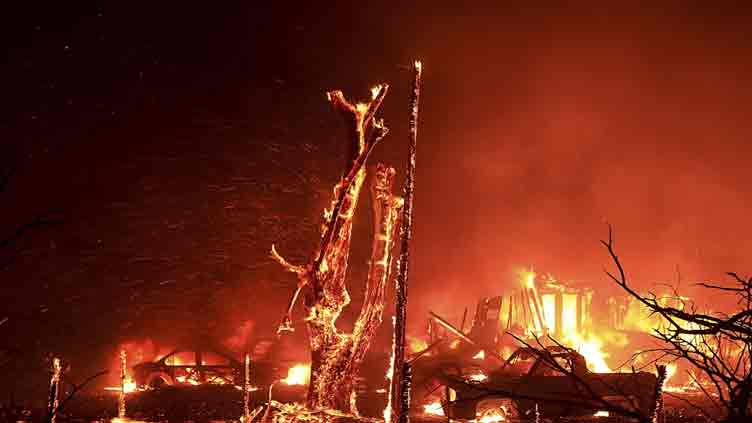Does laser attack really caused massive fires in Los Angeles, let's know

Images of trees left standing amid burned homes in LA no evidence that fire caused by energy weapons
(Web Desk) - Individual trees can survive a fire depending on the moisture they contain and how fast the fire moves, experts opine.
So images of trees left standing amid burned homes in Los Angeles are not evidence the fires were caused by so-called directed-energy weapons or laser attacks.
As of Jan 13, high winds were expected to return to LA, jeopardizing efforts to contain two massive wildfires that began the previous week and have leveled whole neighborhoods, claiming the lives of at least two dozen people and burning an area the size of Washington, DC.
As the fires continued to burn, one Facebook user shared an aerial video of houses destroyed by the flames, with the caption: “Again! Why do I see all those trees intact? DEW Direct Energy Weapons is my answer!!!.”
Another said: “Palisades , CA ..latest Directed Energy Weapon attack..trees left intact while cars melt..HAARP used to fan flames…"
The narrative that trees remained unaffected because the fires were caused by some form of directed attack was also shared in August 2023 during the Maui, Hawaii, fires.
Reuters has also previously addressed a false narrative that claims the University of Alaska's High-frequency Active Auroral Research Program (HAARP) can create or modify the weather.
However, experts told Reuters the images of trees still standing after wildfires are the result of the trees' composition, especially their water content, and the behavior of flames.
INTERNAL MOISTURE
Jon Keeley, a fire scientist with the US Geological Survey, said in an email: "It is not uncommon for wildfires that burn through urban areas to observe trees surviving while adjacent homes are incinerated.
"The primary reason is that trees have roots that bring water up to keep the foliage moist. Homes do not. They are constructed from dried materials and typically are at equilibrium with ambient conditions."
Another factor is wind, Keeley said. “Trees are more likely to survive because moist foliage will not burn until it is heated sufficiently to drive off the moisture. When the winds are moving fast often it is past the trees before they have dried sufficiently to ignite.”
Lenya Quinn-Davidson, director of the University of California Agriculture and Natural Resources Fire Network, also said that it is common to see standing trees after urban fires.
Often, Quinn-Davidson said, the most flammable materials are the homes themselves, or materials directly adjacent to the home, while trees may have higher water content than these more flammable materials, and less likely to capture embers.
“Tree survival during a wildfire will depend on many things, including the physical adaptations and conditions of the tree itself, as well as the nature of the wildfire (fuels, weather, fire spread),” she added.
Robert York, co-director of Berkeley Forests at UC Berkeley, said this phenomenon is common in both urban and rural areas: "We expect very high variability in mortality from tree to tree in situations where there is heterogeneity - i.e. space between trees or groups of trees."
Living trees have high internal moisture, meaning significant heat is needed for them to burn, York said. "Sometimes extreme conditions result in 100% tree mortality. But very often, tree mortality is mixed, with significant variations from one acre to another."



